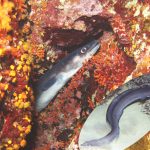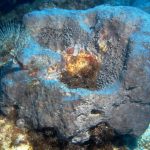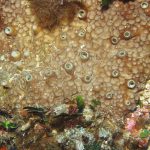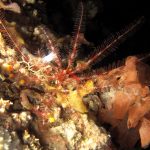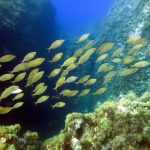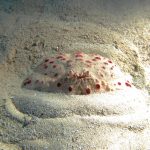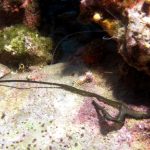Thuridilla hopei, the Hope’s Elysia, is a species of sacoglossan sea slug, a shell-less marine opisthobranch gastropod mollusk endemic to the Mediterranean Sea. Although it usually only occurs in the Mediterranean, it has also been spotted in the Red Sea. In fact, this would not be the first species that crossed the border between these two seas.
The genus Thuridilla belongs to the family Plakobranchidae, superfamily Plakobranchoidea, order Sacoglossa, class Gastropoda, phylum Mollusca and kingdom Animalia.
Although Hope’s Elysia can be found up to depths of 40 metres, is mostly seen in very shallow waters. It is often found near brown or green algae, frequenting rocky and well-lit sea-beds where these algae grow.
This mollusk has a long, smooth and thin body, varying in length from 10 to 25 mm. On each side of its body, Thuridilla hopei has parapodia, lateral extensions united to the back, coming to fold and join on the back of the animal. Concerning the general appearance of this species, the parapodia form an elongated sheath from which the head emerges.
The color of Hope’s Elysia is, most often, blue to violet. However, it can also be found in other shades such as green and dark gray, almost black. It always shows several bands (generally 3) of variable colors in the upper parapodia, in the axis of the back where these parapodia meet. The border line, the outermost, is almost always yellow or orange (rare individuals have a white band). The presence of this line is constant.
Two other colored bands are visible:
- An intermediate line, parallel to the yellow border, is generally blue to turquoise and may optionally be discontinuous.
- The last parallel band, the innermost, is white or yellow, a shade that may be unrelated to that of the border.
On the flanks of the animal, on the lower part of the parapodia, one can sometimes observe yellow or white punctuations under the colored lines. The base of the foot is often white as well.
These different variations make it possible to encounter individuals that are quite diverse in terms of coloring.
In front of the parapodia, the head bears two rhinophores. These are quite long (up to 4 mm), robust and widened at the top, rolled up on themselves. One can observe a white ‘V’ shaped mark, opening from the parapodia’s cover and extending to the rhinophores. At the base of the rhinophores, bordering the white mark, one can easily notice two small black dots. These are the eye spots.
Thuridilla hopei is a vegetarian. It is often found on green algae (including Cladophora vagabunda, Derbesia tenuissima, etc …) which it actually feeds on. Like most of the sacoglossus, Thuridilla hopei perforates the cells of the prey algae, thanks to its radula, acting like a saw, a knife, so as to suck the contents.
The species is a hermaphrodite and two individuals are necessary for reproduction. The relationship is proximal, and one often encounters two Hope’s Elysia procreating entwined two by two in a very explicit posture! The reproductive tract opens on the right side of the animal, almost at the rear base of the right rhinophore, which implies this contact head-to-head partners (even if the bodies intermingle). The penis, a rare and notable thing among the sacoglosses, is bright red.
Like all the sacoglosses, Thuridilla hopei does not have a branchial plume, nor any shell (internal or external). Breathing is through the integument.
The photo of this Hope’s Elysia was taken at a depth of 4m at Reqqa Point, on Gozo’s north coast.
Photo taken by Brian Azzopardi


